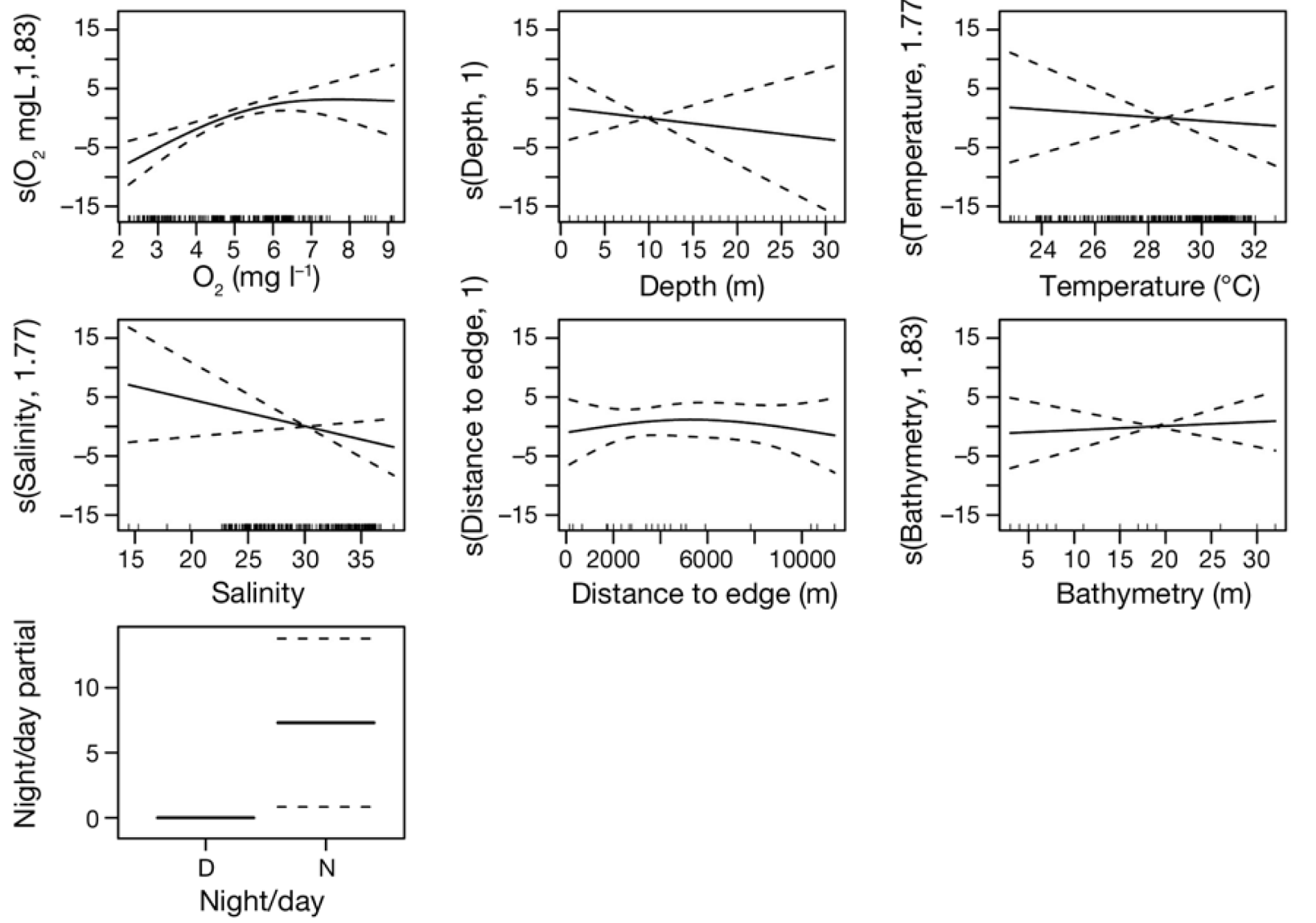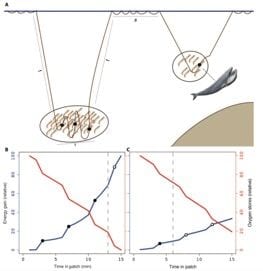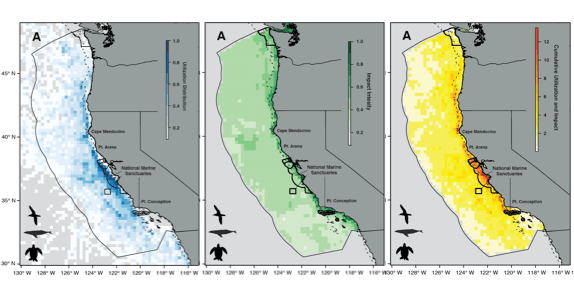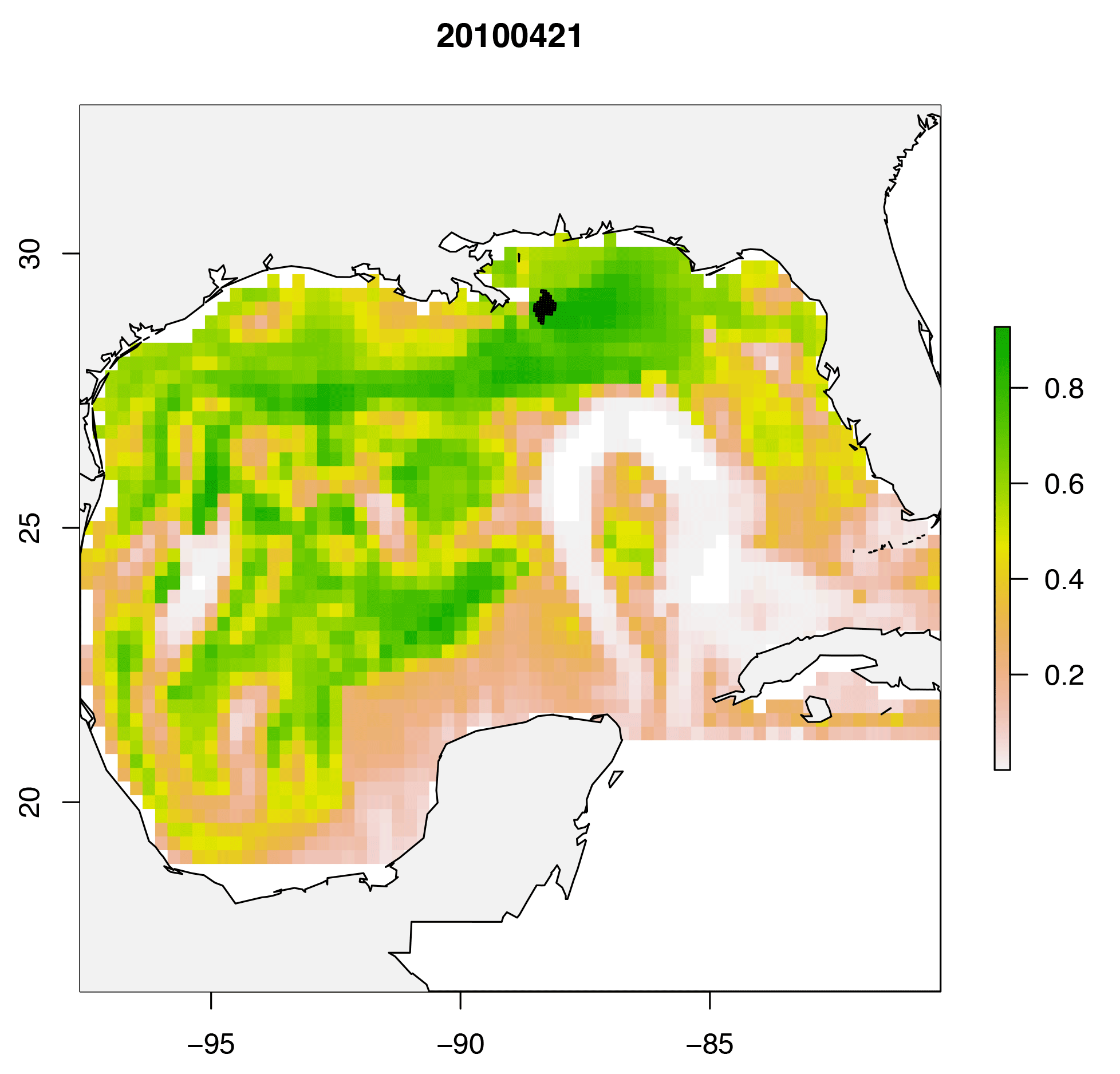My research aims to tease apart ocean, climate, and trophic effects on marine ecosystems. I often combine theoretical and experimental techniques with interdisciplinary collaborators to determine marine species-habitat relationships, predator-prey dynamics, and the effects of climate variability and change on pelagic biodiversity hotspots. I have worked in a variety of systems and a suite of ecological scales around the world often focusing on top predators that need to find dense prey patches to thrive. I have enjoyed working on fine scale foraging ecology of whales, up to basin scale analyses of habitat and likely shifts with climate change, and human dimensions of marine ecosystem based management. I highlight a few examples of my research projects below with much of my code available on GitHub.
Species Ecology, Movement, and Distribution
Species distribution models (SDMs) are commonly used as a tool to identify the physical and biological variables that influence how an organism is distributed. I use a suite of models that can examine linear interactions, threshold effects, and non-linear dynamics to understand how pelagic organisms are distributed relative to oceanographic and bathymetric features.
Nutrient runoff from the Mississippi River results in large areas of productivity
and decomposition in the northern Gulf of Mexico. As phytoplankton decompose,
the oxygen is used up resulting in a “dead zone” where extremely low oxygen limits the organisms that can inhabit demersal waters.
Using fisheries acoustics and net trawls, we found that fish in the Gulf of Mexico
can be vertically compressed above low-oxygen waters resulting in more dense
patches. This compression can directly effect food webs and ecosystem
processes requiring a better understanding of the dynamics in play.
Foraging Theory and Behavior
Humpback whales are cosmopolitan predators that typically feed seasonally in high latitude areas. Traditional foraging habitats maintain predictably high prey concentrations over time, and are often characterized by proximity to shore, dynamic bathymetry, upwelling, and increased productivity.
Stellwagen Bank in the Gulf of Maine is an important feeding site for humpback whales. Animals exhibit a wide variety of surface-feeding strategies, and include lunge feeding, bubble-feeding, lobtail feeding, and other idiosyncratic feeding styles. The data on these whales spans generations and provides a remarkable dataset for understanding their population and ecology in the northwest Atlantic.
We found that oceanographic features such as internal waves were important factors in creating dense patches of sand lance in the water column, and that whales responded directly to the density, location, and shape of these patches of prey. Specifically, dense and vertically oriented prey patches are more likely to be targeted.
Most recently, we have been examining how foraging effort changes as a function of prey density in North Pacific blue whales. We found a very sophisticated strategy of maximizing energy gain when foraging on dense prey patches, and minimizing oxygen use when foraging on less dense prey. This efficiency is yet another mechanism that allows maintenance of their extreme body size and can be used to better understand how human impacts may hinder recovery of this sentinel population.
Climate Variability and Change
Climate change has resulted in shifts in species distributions in both terrestrial and marine systems. Climate change ranks as one of the greatest anthropogenic threats to terrestrial biodiversity, although less is known in marine systems. Models assessed by the Intergovernmental Panel on Climate Change estimate that global ocean surface temperatures will rise between 1 and 6° C by 2100.

Remotely sensed environmental and animal distribution data can be combined in a habitat-modeling framework to both assess and predict how animals interact with their environment. The Tagging of Pacific Predators (TOPP) program resulted in an unprecedented biologging data set by deploying over

Hazen et al. 2013 Nature Climate Change
4,300 electronic tags on 23 species from 2000 to 2009 in the North Pacific. We leveraged existing products from this dataset to examine the potential effects of climate change on a number of marine top predators.
We combined models of observed species distribution as a function of sea surface temperature, chlorophyll-a, and bathymetry with global climate models, and estimated changes in species-specific core habitat and basin-scale patterns of biodiversity over the next century. We were able to reproduce biodiversity hotspots using models based on temperature, chlorophyll, and bathymetry alone. Our results indicate up to a 35% change in core habitat for some species, significant differences in rates and patterns of habitat change across top predator guilds, and a substantial northward displacement of biodiversity across the North Pacific. Managing our oceans in a changing climate will require a suite of adaptive tools.
Applied Ecology and Management
Traditional management approaches in the marine realm have a time-based (seasonal fisheries) or space-based (protected areas) approach. However, particularly for pelagic animals that migrate large distances, a more dynamic approach is needed that tracks habitat in space and time. I am working with colleagues at ODU, OSU, UMD, SDSU, NOAA and Stanford to help create more dynamic management approaches that can be updated in near-real time for use by resource users and managers.
To do this, we need a) representative habitat models of species occurrence or density, b) oceanographic data in near-real time, and c) an understanding of risks throughout the area of interest. Above is a plot of species habitat use combined with sensitivity and intensity of risks (Halpern et al. 2009, Maxwell et al. 2013).
To the right is a draft product called WhaleWatch, where we are working to predict blue whale density in near-real time to reduce likelihood of ship strikes. This product predicts blue whale density each month with daily predictions in development (right) and is automatically delivered to the regional office via restful URL.
We have used similar techniques to examine bluefin tuna habitat relative to oil exposure from the Deepwater Horizon spill (left), to quantify potential impact and in turn damage to the population. This predictive model can also be expanded to other uses where dynamic Bluefin habitat predictions may improve timeliness of management.
The ability to use dynamic habitat predictions to improve our management of marine resources is becoming increasingly important with recent extreme climate/ocean events such as “the Blob.”
We have created a dynamic tool to examine the tradeoffs between target catch and bycatch for the California Swordfish fishery, termed EcoCast. The goal of EcoCast is to provide both fishers and managers with daily predictions of areas where target catch is predicted to be high and bycatch is predicted to be low. It is important for the tool to remain dynamic, so that managers can change risk weightings as management priorities change. In addition, new species can be added as species distribution models are fit and validated. The product requires ongoing testing to ensure that the species-environment relationships will hold into the future, but can be updated as new data become available.
Tools such as WhaleWatch and EcoCast are meant to serve as case-studies that can provide a climate-ready approach towards resource management, in that they are built to automatically adjust and adapt from normal to extreme conditions whether due to variability or long-term change.







